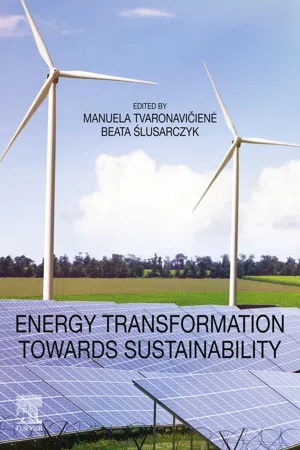
- 348 pages
- English
- ePUB (mobile friendly)
- Available on iOS & Android
Energy Transformation towards Sustainability
About this book
Energy Transformation towards Sustainability explores how researchers, businesses and policymakers can explore and usefully improve energy systems and energy consumption behavior, both to reflect the reality of climate change and related environmental degradation and to adapt to the expanding periphery of renewable energy technologies. It introduces the reader to a suite of potential policy pathways to the necessary transformation in societal energy consumption, usage and behavior. Solutions discussed include energy efficiency, energy security, the role of political leadership, green public policy, and the transition to renewable energy sources.International contributions address the range and depth of current research from a position of advocacy for 'energy stewardship' as the driver of this transformation. Case studies illustrate the range of various countries to diminish energy use. Finally, policy avenues are covered in depth.- Reviews the interrelationship between economic growth, energy consumption and climate change- Uses a wide variety of case studies to support practical implementation across national energy systems- Highlights a wide spectrum of urgent issues, including threats related to energy use and secure and sustainable development- Contains contributions that reflect a breadth and depth of scholarship from international backgrounds
Frequently asked questions
- Essential is ideal for learners and professionals who enjoy exploring a wide range of subjects. Access the Essential Library with 800,000+ trusted titles and best-sellers across business, personal growth, and the humanities. Includes unlimited reading time and Standard Read Aloud voice.
- Complete: Perfect for advanced learners and researchers needing full, unrestricted access. Unlock 1.4M+ books across hundreds of subjects, including academic and specialized titles. The Complete Plan also includes advanced features like Premium Read Aloud and Research Assistant.
Please note we cannot support devices running on iOS 13 and Android 7 or earlier. Learn more about using the app.
Information
Global energy consumption peculiarities and energy sources
Role of renewables
Abstract
Keywords
Introduction
Table of contents
- Cover image
- Title page
- Table of Contents
- Copyright
- Contributors
- Preface
- Acknowledgments
- Chapter 1. Global energy consumption peculiarities and energy sources: Role of renewables
- Chapter 2. Energy consumption and greenhouse gas emissions against the background of Polish economic growth
- Chapter 3. National growth and regional (under)development in Brazil: The case of Pará in the Brazilian Amazon
- Chapter 4. Energy consumption and income distribution. International policies for mitigating social exclusion
- Chapter 5. What does energy security mean?
- Chapter 6. Weather risk and energy consumption in Poland
- Chapter 7. International conflicts related to energy: A case study of Lithuania's opposition to the construction of Russian nuclear power plants near its borders
- Chapter 8. Case study: Free public transport as instrument for energy savings and urban sustainable development—the case of the city of Tallinn
- Chapter 9. Carsharing concept implementation in relation to sustainability – Evidence from Poland
- Chapter 10. Electromobility for sustainable transport in Poland
- Chapter 11. Toward solutions for energy efficiency: Modeling of district heating costs
- Chapter 12. Small business energy challenges and opportunities
- Chapter 13. Promotion of renewable energy in Morocco
- Chapter 14. Social responsibility, social marketing role, and societal attitudes
- Subject Index
- Author Index